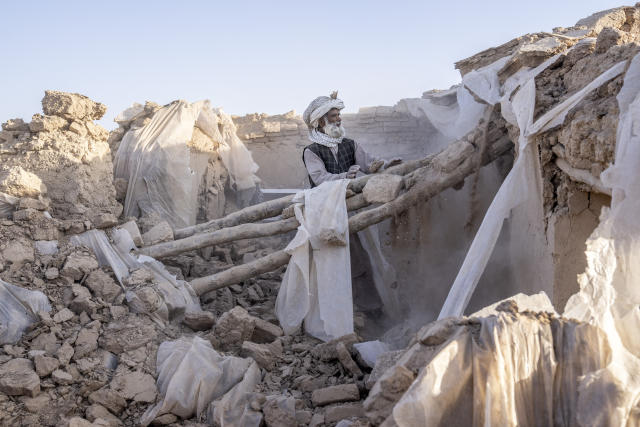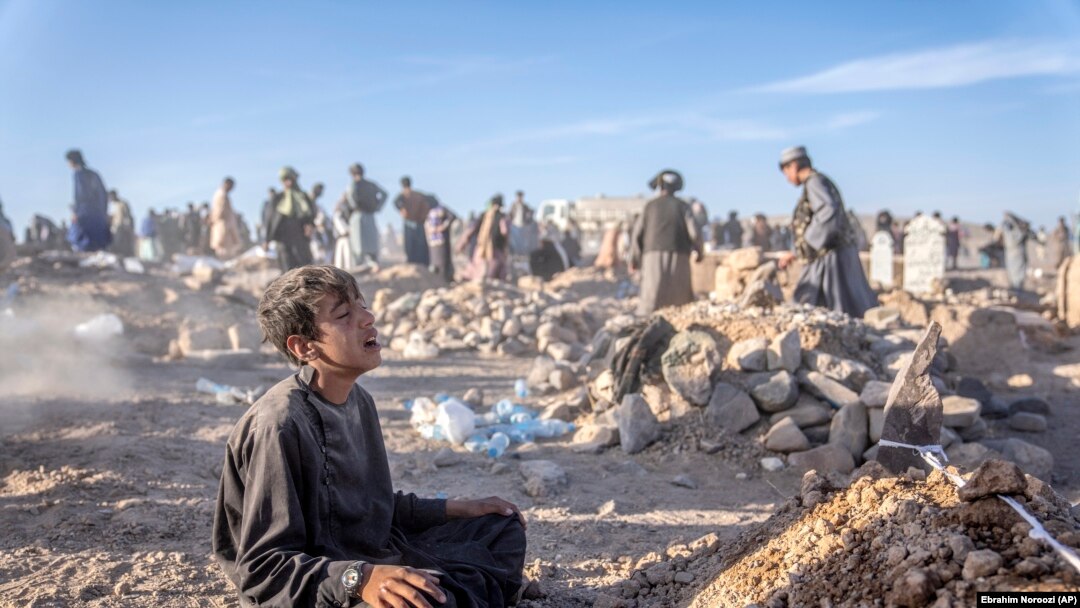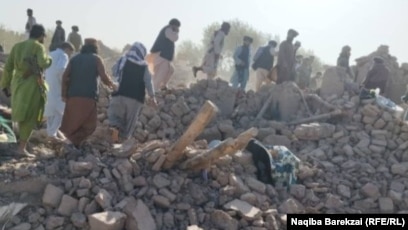Devastating 6.3 Magnitude Earthquake Rocks Afghanistan, Heightening Fears and Uncertainty

Devastating 6.3 Magnitude Earthquake Rocks Afghanistan, Heightening Fears and Uncertainty
In a region already reeling from a series of catastrophic seismic events, a powerful 6.3 magnitude earthquake struck western Afghanistan on a harrowing Sunday, casting fresh waves of fear and uncertainty among the affected population. Just days after the initial quakes and relentless aftershocks claimed the lives of thousands, this latest disaster hit near the city of Herat, leaving residents and authorities grappling with the grim reality of yet another natural catastrophe. At a depth of 6.3 kilometers, this tremor added to the mounting challenges faced by the beleaguered region.
The United States Geological Survey (USGS) swiftly reported the seismic event, capturing the attention of the global community and underlining the need for prompt humanitarian aid. As of now, there are no immediate official reports of potential casualties or damage resulting from this most recent earthquake, but the scars left by previous tremors have not yet healed, serving as a stark reminder of the profound vulnerability of this earthquake-prone region.
This article delves into the details of the recent earthquake, its potential consequences, and the broader context of seismic activity in Afghanistan. It aims to provide a comprehensive overview of the situation and the challenges faced by both the local population and the relief efforts.
Unprecedented Challenges in the Aftermath
Afghanistan’s history is marred with instances of natural disasters, but the recent seismic onslaught is particularly devastating. The previous weeks have seen a relentless series of strong quakes and aftershocks that have already claimed the lives of thousands, disrupted communities, and strained the nation’s resources. The magnitude 6.3 earthquake that rattled Herat adds to this tumultuous narrative, compounding the difficulties faced by a population that is already on the brink.
The precise impact of the latest quake remains uncertain at this time. However, given the region’s susceptibility to such natural disasters, there is widespread concern that this seismic event could further exacerbate the ongoing crisis. Local authorities are on high alert, and international aid organizations are mobilizing resources to provide relief to the affected areas.

The Vulnerable Region: Afghanistan’s Seismic Hotspot
Afghanistan, situated in a seismically active zone, has long been recognized as a hotspot for earthquakes. The country is part of the Alpine-Himalayan seismic belt, characterized by the convergence of the Indian and Eurasian tectonic plates. This geological reality makes Afghanistan highly prone to seismic activities, including earthquakes and their often destructive aftershocks.
The collision of these tectonic plates creates immense pressure, which is periodically released in the form of earthquakes. These earthquakes can vary in magnitude and have the potential to inflict substantial damage on the built environment and the lives of those inhabiting it. As a result, Afghanistan remains highly vulnerable to such natural disasters, and the recent series of quakes serves as a stark reminder of this vulnerability.
The Science of Earthquakes
To understand the significance of the 6.3 magnitude earthquake in Herat, it is essential to grasp the science behind earthquakes. Earthquakes occur when there is a sudden release of energy in the Earth’s crust. This release of energy generates seismic waves that cause the ground to shake. The magnitude of an earthquake is determined by the amount of energy released. The Richter scale, often used to quantify earthquake magnitude, ranks them on a scale from 1 to 10.
A 6.3 magnitude earthquake is considered a strong earthquake and can result in considerable structural damage and pose a significant risk to human life, particularly in areas with inadequate building standards and infrastructure.

The Human Toll: A Nation in Distress
The impact of these seismic events on the Afghan population is nothing short of catastrophic. The initial earthquakes and aftershocks have caused extensive damage to infrastructure, homes, and public facilities. Furthermore, the loss of life has been substantial, with thousands already confirmed dead and many more injured.
These numbers are a grim reminder of the human toll that such natural disasters can take in a region where emergency response and healthcare systems are often ill-equipped to handle such crises. In remote areas, access to medical care and shelter remains a significant challenge, leaving many vulnerable to injury and exposure.
Moreover, the psychological toll on the survivors cannot be underestimated. The constant threat of aftershocks, the loss of homes and possessions, and the mourning of loved ones have created a state of fear and uncertainty that plagues the affected population. PTSD (Post-Traumatic Stress Disorder) and other mental health issues are likely to be long-term consequences of this disaster.
Relief Efforts and the Global Response
In the wake of these catastrophic earthquakes, the Afghan government, local authorities, and international relief organizations have mobilized to provide assistance to the affected regions. Emergency response teams have been dispatched, and temporary shelters are being set up to house those who have been displaced by the disaster.
Humanitarian agencies, both domestic and international, are working diligently to provide food, clean water, medical aid, and other essential supplies to the affected communities. The United Nations and various non-governmental organizations have launched fundraising campaigns to support these relief efforts, recognizing the urgency of the situation.
The global response to Afghanistan’s earthquake crisis highlights the solidarity of the international community in times of dire need. Nations, organizations, and individuals are contributing resources, personnel, and financial support to help mitigate the suffering caused by these natural disasters.
Challenges in Relief and Recovery
While the relief efforts are commendable, several challenges must be addressed to effectively assist the affected population and help rebuild their lives. Some of these challenges include:
1. Accessibility: Many affected areas are in remote, mountainous regions, making access for relief teams difficult. The rugged terrain and damaged infrastructure hinder the efficient distribution of aid.
2. Communication: Disrupted communication networks complicate coordination among relief agencies and impede the flow of critical information.
3. Inadequate Infrastructure: Afghanistan’s fragile infrastructure, already weakened by years of conflict, is further damaged by the earthquakes, making it challenging to provide medical care and relief effectively.
4. Political Instability: Afghanistan has been grappling with political instability, which can impact the coordination of relief efforts and hinder the allocation of resources.
5. Long-term Recovery: Rebuilding homes, schools, and public facilities will be a protracted and costly process, requiring sustained international support.
Looking Forward: A Resilient Afghanistan
As the Afghan population continues to endure the devastating consequences of these earthquakes, it is essential to look forward and consider the steps necessary to build a more resilient nation in the face of future natural disasters.
1. Better Infrastructure: Investment in infrastructure that adheres to seismic building codes is crucial. Stronger buildings and bridges can better withstand earthquakes, reducing casualties and damage.
2. Early Warning Systems: Developing and implementing early warning systems can provide communities with vital seconds or minutes to prepare for an impending earthquake, potentially saving lives.
3. Public Awareness: Education and awareness campaigns can help the population understand how to respond to earthquakes and mitigate their risks.
4. Psychosocial Support: Mental health services should be an integral part of disaster response efforts, helping survivors cope with trauma and loss.
5. International Solidarity: The global community must maintain its commitment to supporting Afghanistan in its recovery and resilience-building efforts.

Conclusion
The 6.3 magnitude earthquake that struck Herat, Afghanistan, has compounded the immense challenges facing a nation already grappling with the aftermath of earlier devastating earthquakes. The ongoing response to this crisis showcases the resilience of the Afghan people and the compassion of the global community.
Efforts to assist the affected population are underway, but numerous obstacles persist in providing relief and initiating the long-term process of recovery. Despite the challenges, this moment highlights the urgency of addressing Afghanistan’s vulnerability to earthquakes and investing in measures to build a more resilient and prepared nation.
As Afghanistan navigates this tumultuous period, the world watches with hope, knowing that solidarity and support are essential to helping the country recover and rebuild after these harrowing seismic events.




